CRM statistics tell a clear story—businesses that invest in smarter customer relationship management consistently outperform those that don’t. As the backbone of modern sales, marketing, and customer service strategies, CRM continues to evolve, integrating AI, automation, and advanced analytics.
To help you stay ahead in 2025, we’ve compiled 16 key CRM statistics and facts backed by reliable sources that highlight the latest trends shaping the industry.
Want to stay ahead of the competition? Learn everything you need to know about the latest crm trends driving the future of business relationships.
General CRM Statistics and Facts
1) CRM Adoption Continues to Grow at a 14.6% CAGR
Gartner reported that CRM became the largest software market in the world in 2018. As one of the fastest-growing software categories, CRM saw a 16% growth rate that year and continues its upward trajectory. From 2025 to 2030, the CRM software market is expected to grow at a compound annual growth rate (CAGR) of 14.6%, reaching an estimated $163.16 billion by 2030.
This substantial growth is not without reason. More and more start-ups emerge every year, filling the market with new players and bolder products/services; sales teams need a reliable sales hub that can sync all sales touch points wherever they are.
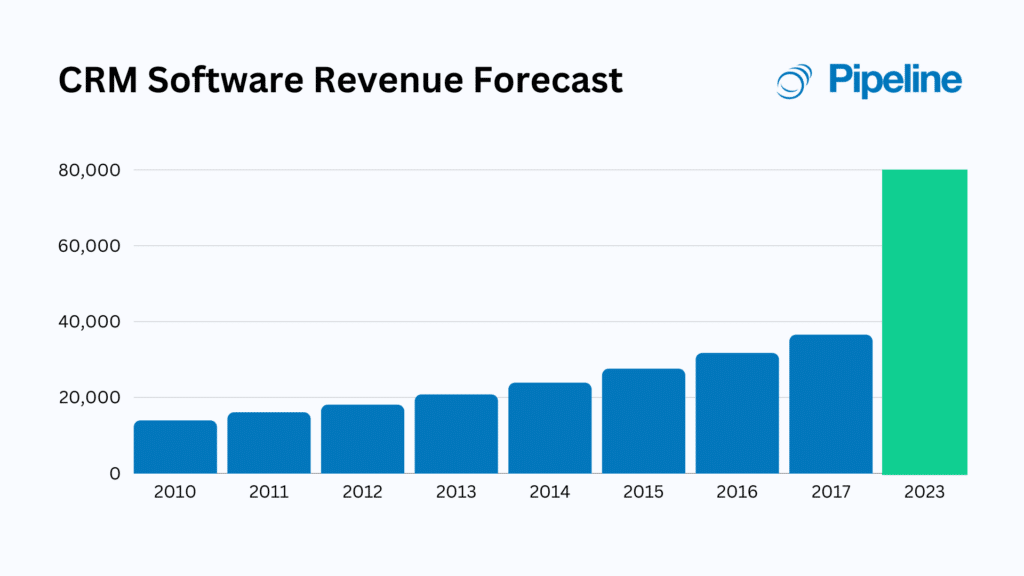
2) 44% of Buyers Reject Sales Pitches from Unprepared Reps
Sales teams aren’t the only ones navigating an increasingly competitive market—buyers are feeling the pressure, too. They are more discerning than ever, with 60% saying they reject a pitch at least four times before considering a “yes.”
Being unprepared is a deal-breaker. A staggering 82% of B2B decision-makers believe sales representatives lack proper preparation in meetings, and 44% of buyers say they will immediately dismiss a sales call if the salesperson hasn’t researched their company and needs. With information overload, personalized, well-informed outreach is essential to winning deals.
3) 86% of B2B Marketers Say Personalized Content Is Key to Success
First impressions matter—a lot. People form judgments within seconds of meeting someone, and those impressions tend to stick.
But it’s not just about looking the part. Personalization is what really gets buyers to engage. A massive 86% of B2B marketers agree that personalized content is key to success.
43% of the respondents say they will likely select a sales professional’s company as a vendor if they have a favorable impression when meeting with the sales reps. Another study claims that 59% of customers consider tailored engagement as the key to gaining their attention.
This means salespeople need to do their homework before a meeting, such as finding the prospect’s pain points, knowing which features of their products/services are effective in solving their problems, and anticipating any issues that may arise during the negotiations.
This shift in the buyer’s behavior pushes businesses to implement a sales tool like CRM into their daily work—helping them put buyer satisfaction above anything else.
| 77% of sales professionals say their organization plans to invest more in sales intelligence tools—including CRMs. This will help them reduce the time they spend on administrative and non-selling duties, which amount to 30% of their time. |
AI CRM Statistics
4) 28% Increase in CAGR for AI CRM
The global AI in CRM market is expected to expand to USD 48.4 billion by 2033 with a CAGR of 28% from 2024 to 2033, probably because of:
- Rising demand for personalization
- Need for faster decision-making
- Automation of repetitive tasks
Even the term “AI CRM” has shown steady growth on Google Trends in the past year.
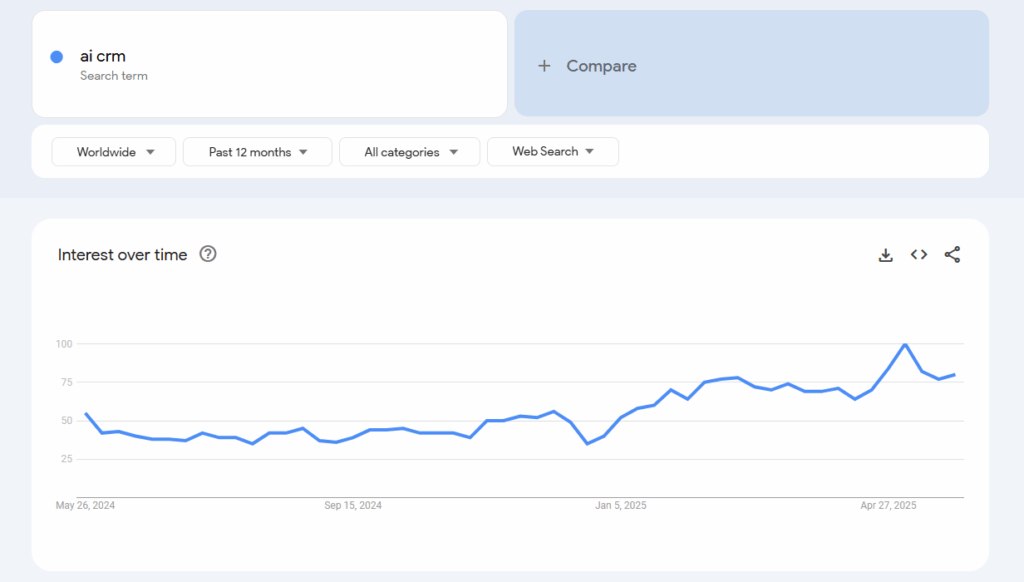
… and it shows no signs of stopping.
5) G2 Listed 794 CRM Software
In fact, G2 currently has 794 listings of CRM available.
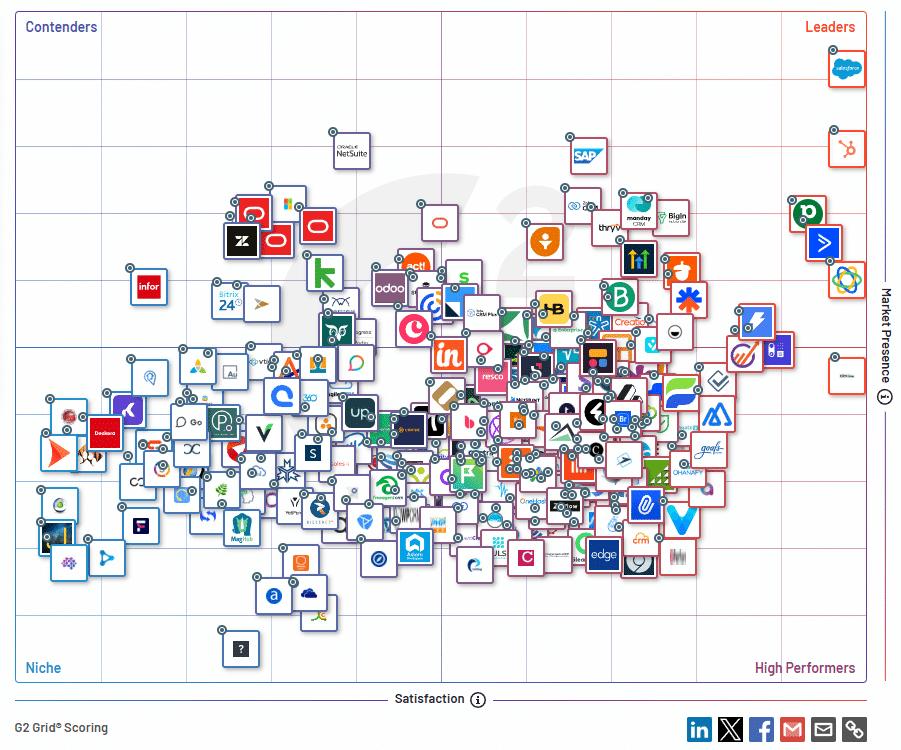
6) Lead Generation and Customer Retention are the Most Used CRM Functions
The top use case? Lead generation and customer retention.
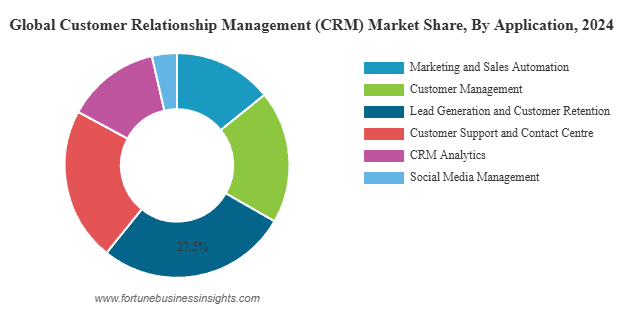
To stay competitive, you need more than just data; you need intelligence.
An AI-powered CRM can come to the rescue since it analyzes, predicts, and prioritizes. The result? Faster response times, smarter routing decisions, and more meaningful customer relationships.
CRM Adoption Statistics
7) 70% of Sales Reps Believe CRM Helps Close More Deals
Navigating the shift from in-person to online meetings has introduced new challenges for sales teams. Building trust and demonstrating a deep understanding of buyers’ needs within these constraints is crucial. It’s no surprise that 54% of sales professionals rely on tools like CRM systems to foster stronger relationships with buyers, leading to more closed deals.
| 70% of salespeople say CRM is very important to closing deals. |
8) More than 45% of CRM Usage is for Contact Management and Automation
Every sales professional knows the long and winding road it takes for a prospect to sign a deal. It demands a lot of research, approach attempts, negotiations, and follow-ups. This is where adopting a CRM becomes very helpful. With its many extensive functions (see the top CRM functions on the chart below), a CRM will help you accelerate and make the deal-closing journey less stressful.
Based on a CRM buyer survey, the top three problems that most companies want to solve from a CRM adoption are contact management (50%), sales management (33%), and lead generation (33%).
Additionally, they are also interested in having CRM software that can automate specific sales tasks and processes (45%), have numerous integrations (36%), and can well support their on-field workers (20%).
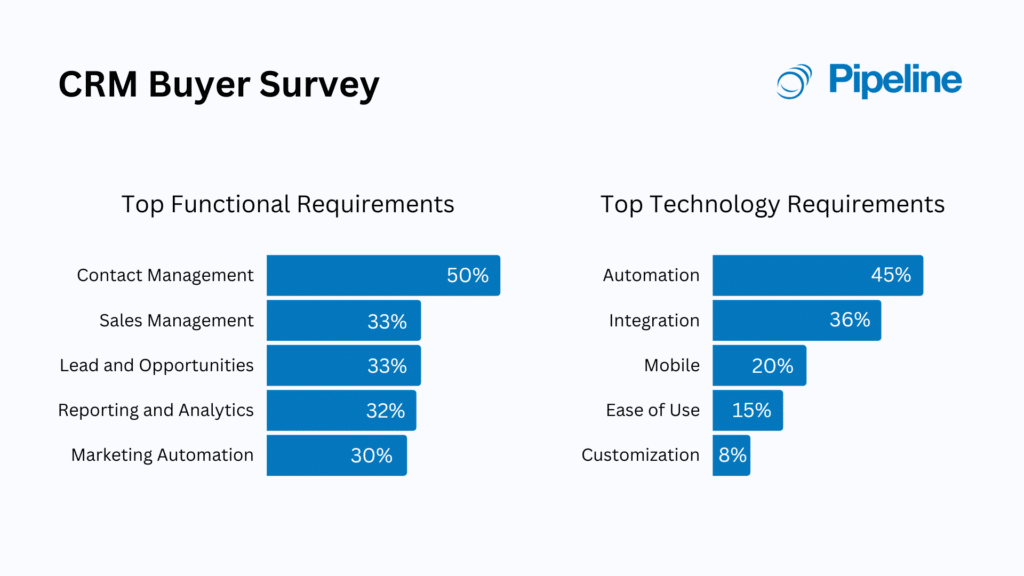
9) 57% of CRM Automation is Dedicated to Lead Nurturing
Another study also suggests the importance of CRM automation in helping organizations in different areas of sales. They vary from lead nurturing (57%) to customer engagement (36%) to campaign reporting (28%). This is particularly important, considering more than eight of ten sellers claimed that they lost deals due to a key stakeholder leaving a prospect company.
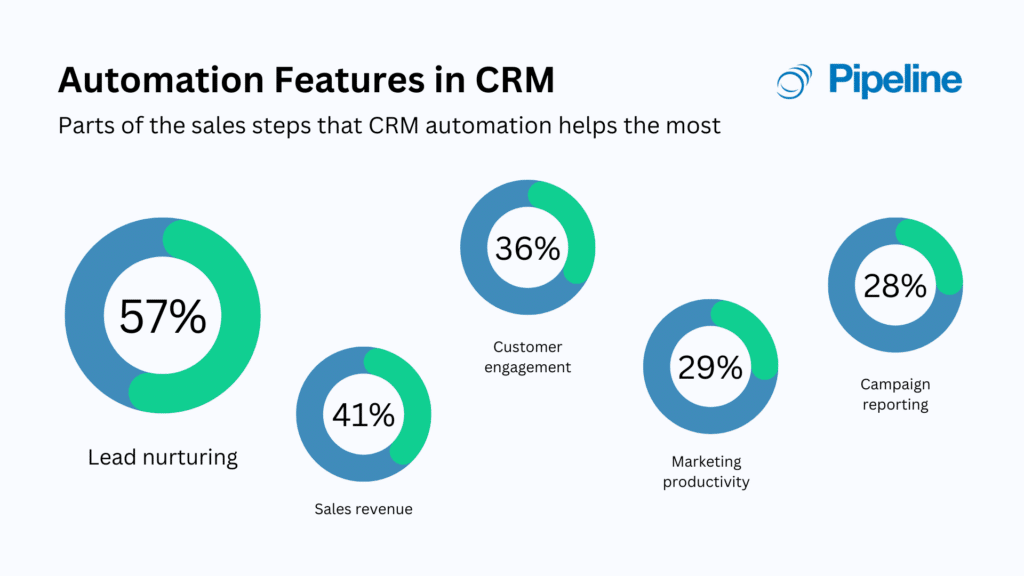
10) 97% Increase in AI and Big Data Adoption in CRM by 2030
AI and big data are becoming essential in the SaaS and CRM industries, and the trend isn’t slowing down anytime soon. According to Statista, AI and big data adoption in these sectors is projected to skyrocket by 97% between 2025 and 2030.
As businesses prioritize data-driven decision-making and automation, CRM platforms are evolving to offer smarter insights, predictive analytics, and enhanced customer interactions. This shift means that companies leveraging AI-powered CRMs will gain a major competitive edge in the years to come.
11) 32% of businesses that use CRM are from the service industry
Looking at the many hats a CRM solution wears, it’s clear that CRM is suitable for any kind and any size of business. As long as your business engages with customers, a CRM will give you the upper hand in improving your sales performance.
That said, the services industry (32%), such as real estate, agencies, and construction companies, contribute to the biggest users of CRM by industry, followed by manufacturing and IT businesses (both with 13% share).
CRM Users Statistics
12) 32% of Businesses Using CRM are from the Service Industry
CRM systems are versatile tools that can benefit businesses of all types and sizes. Any company that interacts with customers can leverage CRM software to enhance sales performance and streamline operations.
That said, the services industry (32%), such as real estate, agencies, and construction companies, contribute to the biggest users of CRM by industry, followed by manufacturing and IT businesses (both with 13% share).

13) 65% of SMB Businesses Adopt a CRM Within Their First Five Years
Recent data indicates that 65% of companies implement a CRM system within five years of starting their business.
According to Capterra, more than half of the companies that adopt a CRM started their business at least five years ago.
Furthermore, company size doesn’t dictate when a business adopts a CRM. The chart below shows that the employee count is fairly evenly distributed from companies with 2-9 employees to those with 100-499 employees.
These numbers are particularly interesting since many people believe that large companies benefit most from CRM adoption. In reality, a two-person company also receives a tremendous boost in its business growth. By using a CRM, they can handle hundreds of leads without feeling overwhelmed because everything is neatly organized and trackable on the CRM system. CRM acts as an extra help that many small to medium businesses (SMBs) need.
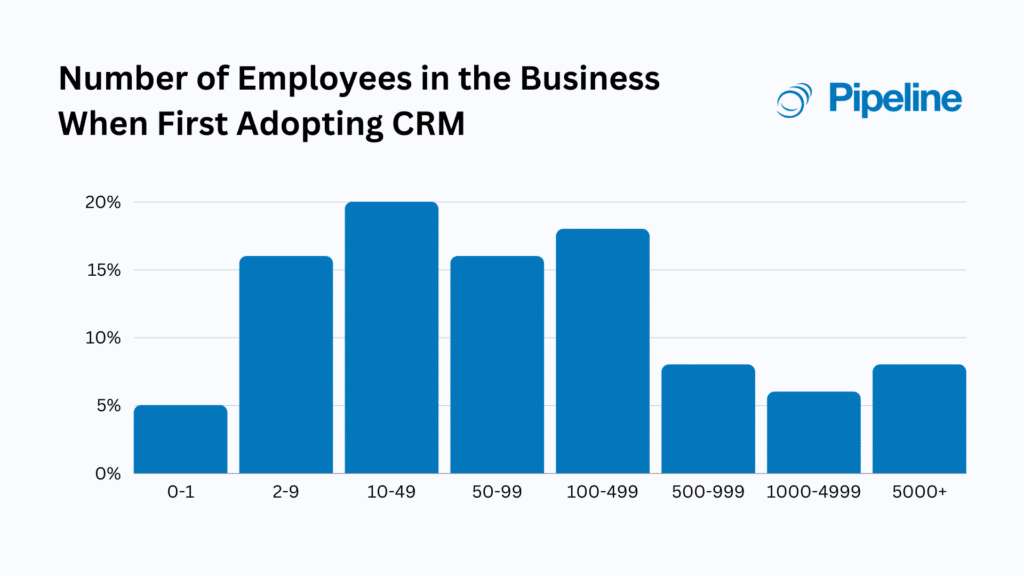
14) More than 45% of Marketing and Customer Service Teams Also Use CRM
CRM may be specifically designed to support sales activities and teams. However, its users aren’t only limited to sales but also to other departments, namely marketing (46%) and customer service (45%).
That said, with more advancements in collaborative workflow, CRM users are no longer exclusive to front-office employees but also back-office teams. For example, the finance/accounting department can have one-stop access to the revenue reports. The legal team can directly help with contract drafting, and the human resources (HR) team can generate objective performance reports.
CRM Benefit Statistics
15) 300% Increase in Lead Conversion Rate
36% of sales professionals feel that closing deals are the most difficult part of the sales process, but with CRM, you can overcome this obstacle and even achieve a 300% increase in conversion rate. How can this happen?
Primarily, CRM improves three main areas of your business: sales activity, team productivity, and company benefit.
- Sales activity: CRM allows salespeople to carefully classify and provide different sales treatments based on the value of the leads to the company, making every sales effort an effective one.
- Team productivity: as the team’s hub, CRM always puts every team member on the same page at every deal stage. Instead of working in silos, the team can share, add, and edit information in real-time. This will reduce internal communication and, in turn, accelerate sales.
- Company benefit: with more on-target sales and marketing tactics, the company will spend less time acquiring new customers. And with more tasks and workflows set on automation, businesses will need fewer employees to hire. A big saving in time and money.
- Data integrity: CRM that is equipped with conditional formatting features empowers you to maintain clean and accurate data. In fact, 45% of salespeople feel their biggest data challenge is incomplete data. As a result, your outreach campaigns can be more on-target, reducing the total costs and bounce rate.
Related: Learn more about how clean data can increase sales performance in this guide.
| Note: These are only a few benefits of CRM adoption. You can get the full list along with some tips on how to choose the right CRM tool in our free CRM handbook. |
16) 47% Growth in Customer Retention and Satisfaction
CRM is useful for converting leads and critical for retaining existing customers. One survey found that companies that implemented CRM experienced a 47% growth in customer retention and satisfaction.
Once a lead becomes a customer, all their purchase activity and buying behavior are recorded in the CRM. Salespeople can then use this data to be proactive in keeping customers loyal to the brand.
For instance, by analyzing the buying cycles, you can predict their next order and offer freebies or special discounts to turn them into repeat customers. You can also see the items customers often buy together and use this insight for cross-selling opportunities and new marketing ideas.
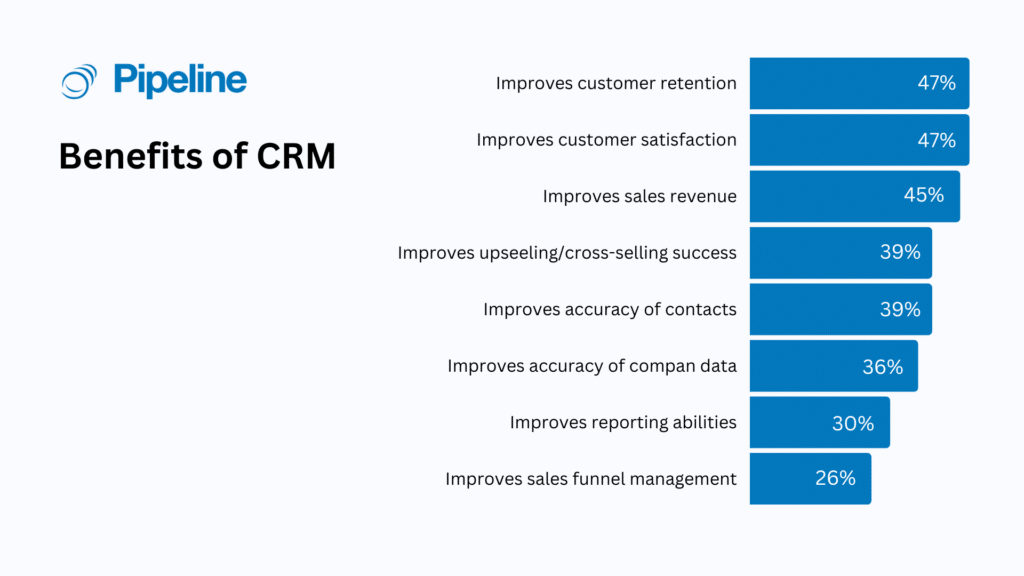
17) Better Data Access Boost Sales Cycles Efficiency by 8-14%
Although using spreadsheets and sticky notes come with many drawbacks, many sales reps are still stuck in this traditional method of data management, refusing to embrace a CRM. This approach may still work in managing small entries of customer data, but when you have hundreds of contacts, leads, and communication touchpoints that need to be updated daily, CRM is the tool you need.
| 74% of CRM users feel their CRM system gives improved access to customer data. |
CRM simplifies data management, and the reasons are no-brainers. With CRM, information is no longer stored in separate spreadsheets scattered across team members. The data collections now have uniform metrics that can be customized and attached with links, documents, and other related data types directly to the entry. Some CRMs even support automatic contact import from emails and social media accounts for a smoother workflow.
All these advanced contact and sales management features allow you to have an organized data management system that helps to minimize lost opportunities and shorten the sales cycles by 8-14%.
18) 65% of Sales Teams Achieve Quotas with Mobile CRM
Companies that implement mobile CRM solutions see a notable boost in performance.
Specifically, 65% of sales teams using mobile CRM meet their sales quotas, compared to only 22% of those without such access. This underscores the importance of real-time data access in achieving sales targets.
19) CRM Adoption Increases Sales Revenue by 21-30%
Beyond meeting quotas, CRM systems contribute to overall revenue growth. Most businesses experience a sales revenue increase of 21-30% after implementing a CRM platform. This boost is attributed to improved customer relationship management and streamlined sales processes.
20) $30.48 of Investment Payback for Every Dollar Spent
In terms of return on investment (ROI), when we forecast the 1.5 times CRM ROI rate, CRM will pay back $45.72 (or more) for every dollar spent by businesses (2024). And the more fantastic news is that this profitable investment can be recouped in just six months or less.
CRM Statistics Prove It’s Your Secret Growth Weapon
The numbers don’t lie—whether it’s boosting productivity, increasing revenue, or delivering jaw-dropping ROI, CRM is doing the heavy lifting for businesses everywhere. It’s not just about organizing data; it’s about empowering your salespeople to work smarter, collaborate better, and keep your customers coming back for more.
Ready to see these CRM statistics come to life for your business? Try Pipeline CRM.
From customizing your workflow to automating repetitive tasks, we’ve got the tools to help you turn one-time buyers into loyal customers. Experience Pipeline CRM today and watch your numbers soar.
More interesting CRM statistics and facts: 9 CRM Statistics That Matter For Sales Teams


